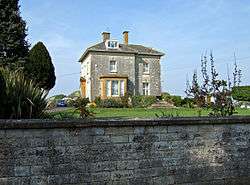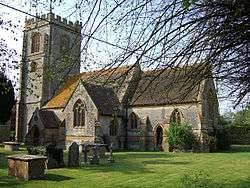Chilton Cantelo
| Chilton Cantelo | |
 The Cypress House |
|
 The Parish Church of St James |
|
 Chilton Cantelo |
|
| Population | 445 (2011)[1] |
|---|---|
| OS grid reference | ST575225 |
| District | South Somerset |
| Shire county | Somerset |
| Region | South West |
| Country | England |
| Sovereign state | United Kingdom |
| Post town | YEOVIL |
| Postcode district | BA22 8 |
| Dialling code | 01935 |
| Police | Avon and Somerset |
| Fire | Devon and Somerset |
| Ambulance | South Western |
| EU Parliament | South West England |
| UK Parliament | Yeovil |
Coordinates: 51°00′01″N 2°36′25″W / 51.0003°N 2.6070°W
Chilton Cantelo is a village and parish in Somerset, England, situated on the River Yeo 5 miles (8 km) north of Yeovil and 4 miles (6 km) east of Ilchester in the South Somerset district. The village has a population of 445.[1] The parish also includes the village of Ashington.
History
The first part of the name Chilton means the young nobleman's settlement, and the second is from William de Cantilupe (or Cantelo) and his descendants who held the manor between 1201 and 1350. The manor was acquired in the 18th century by the Goodford family who built Chilton Cantelo house[2] which later became the home of Chilton Cantelo School,[3] a small private boarding school which is owned and operated by the Cognita Group.
Ashington Manor has pre Norman Conquest origins, and was in the overlordship of Glastonbury Abbey, but the present building is from the 15th century. The families who held the manor include de Curcelle, and from 1390 to 1901 the St. Barbes, becoming St. Barbe Syenha from 1722. In 1940 it passed to the Church Commissioners.[4]
The parish of Chilton Cantelo was part of the hundred of Houndsborough, while Ashington was part of the Stone Hundred.[5]
Governance
The parish council has responsibility for local issues, including setting an annual precept (local rate) to cover the council’s operating costs and producing annual accounts for public scrutiny. The parish council evaluates local planning applications and works with the local police, district council officers, and neighbourhood watch groups on matters of crime, security, and traffic. The parish council's role also includes initiating projects for the maintenance and repair of parish facilities, as well as consulting with the district council on the maintenance, repair, and improvement of highways, drainage, footpaths, public transport, and street cleaning. Conservation matters (including trees and listed buildings) and environmental issues are also the responsibility of the council.
The village falls within the Non-metropolitan district of South Somerset, which was formed on 1 April 1974 under the Local Government Act 1972, having previously been part of Yeovil Rural District.[6] The district council is responsible for local planning and building control, local roads, council housing, environmental health, markets and fairs, refuse collection and recycling, cemeteries and crematoria, leisure services, parks, and tourism.
Somerset County Council is responsible for running the largest and most expensive local services such as education, social services, libraries, main roads, public transport, policing and fire services, trading standards, waste disposal and strategic planning.
It is also part of the Yeovil county constituency represented in the House of Commons of the Parliament of the United Kingdom. It elects one Member of Parliament (MP) by the first past the post system of election, and part of the South West England constituency of the European Parliament which elects seven MEPs using the d'Hondt method of party-list proportional representation.
Religious sites
The Church of Saint Vincent, in Ashington, is from the 13th century.[7]
The Norman church is dedicated to St James. It has a 15th-century tower and parts of the church date from even earlier. It was restored in 1864–65 by Sir Arthur Blomfield. It has been designated by English Heritage as a Grade II* listed building.[8] Theophilus Brome, who died in 1670, had his body buried in the church, however his skull was separated from the body on his instructions and is kept in a cupboard at Higher Chilton Farm.[9] According to writer Daniel Codd, who observed the skull in February 2010: 'Upon being shown Theophilus' skull, I was curious to see his lower jaw was missing and that he appears at some stage to have been varnished.' Codd goes on to say, 'The reason for Theophilus Brome's desire that his head be hidden was very natural, given the era in which he died, and his tomb in the church is concealed beneath the church wall nearest the farm — meaning that his head and body were buried apart, but as near to each other as was possible under the circumstances.'[10] Several attempts to inter the skull have resulted in terrible and unexplained noises being heard throughout the farmhouse.[11][12]
 Higher Farm
Higher Farm Bales near Chilton Cantelo
Bales near Chilton Cantelo
See also
References
- 1 2 "Statistics for Wards, LSOAs and Parishes — SUMMARY Profiles" (Excel). Somerset Intelligence. Retrieved 4 January 2014.
- ↑ "Chilton Cantelo House". Images of England. English Heritage. Retrieved 14 December 2008.
- ↑ Bush, Robin (1994). Somerset: The complete guide. Wimborne, Dorset: Dovecote Press. p. 66. ISBN 1-874336-26-1.
- ↑ "Ashington Manor". Images of England. English Heritage. Retrieved 14 December 2008.
- ↑ "Somerset Hundreds". GENUKI. Retrieved 21 October 2011.
- ↑ "Yeovil RD". A vision of Britain Through Time. University of Portsmouth. Retrieved 4 January 2014.
- ↑ "Church of Saint Vincent". Images of England. English Heritage. Retrieved 10 October 2008.
- ↑ "The Church of Saint James". Images of England. Retrieved 13 January 2008.
- ↑ Leete-Hodge, Lornie (1985). Curiosities of Somerset. Bodmin: Bossiney Books. p. 81. ISBN 0-906456-98-3.
- ↑ Codd, Daniel (2011). Mysterious Somerset and Bristol, Derby Books Publishing. p.86-88. ISBN 9781859839478
- ↑ Anthony D. Hippisley Coxe, Haunted Britain, pg. 46, McGraw-Hill Book Company, New York 1973
- ↑ Peter Underwood, Gazetteer of British Ghosts, pg. 49, Walker and Company, New York 1971
External links
| Wikimedia Commons has media related to Chilton Cantelo. |
- Chilton [Cantelo] in the Domesday Book
- Ashington in the Domesday Book
